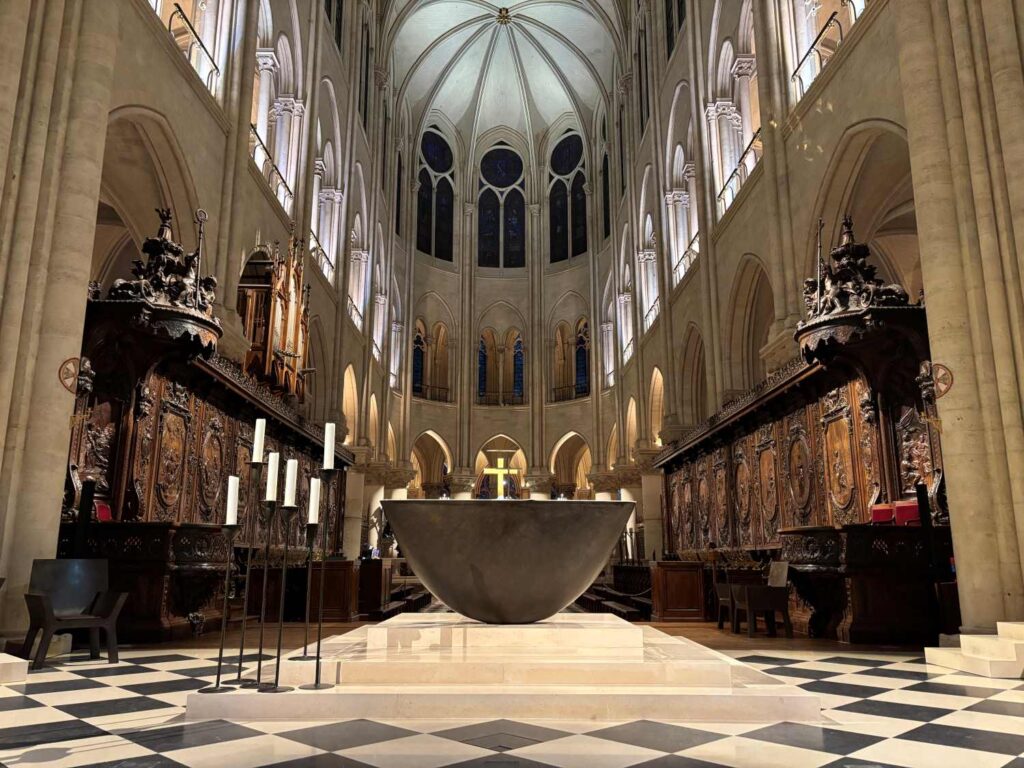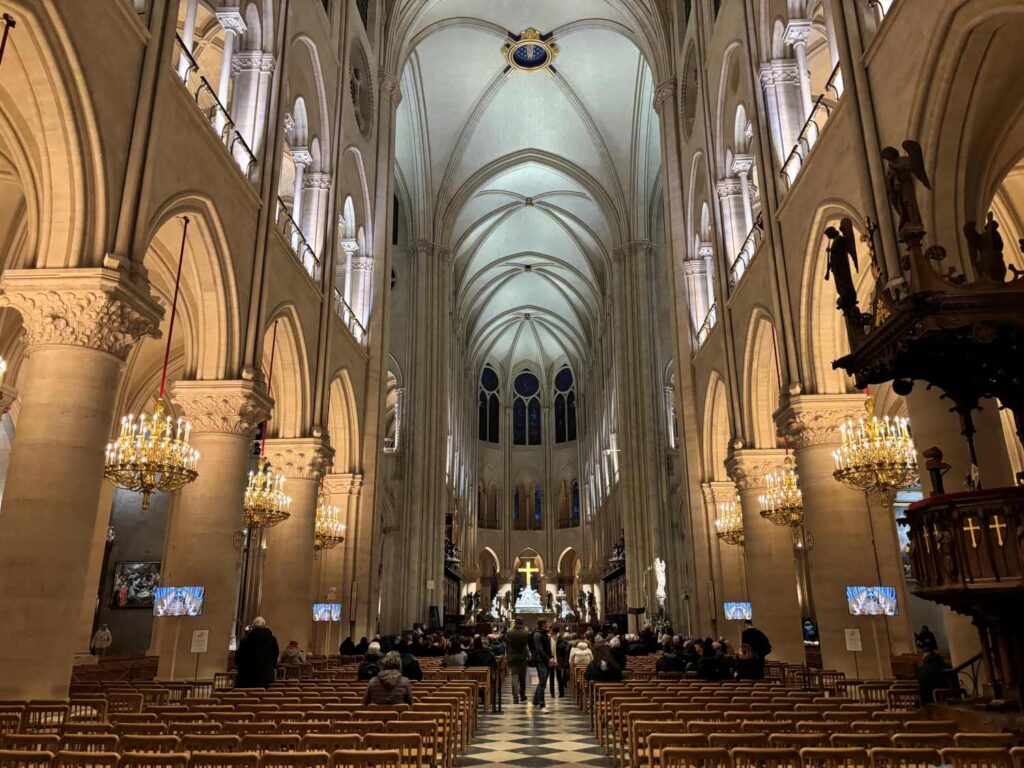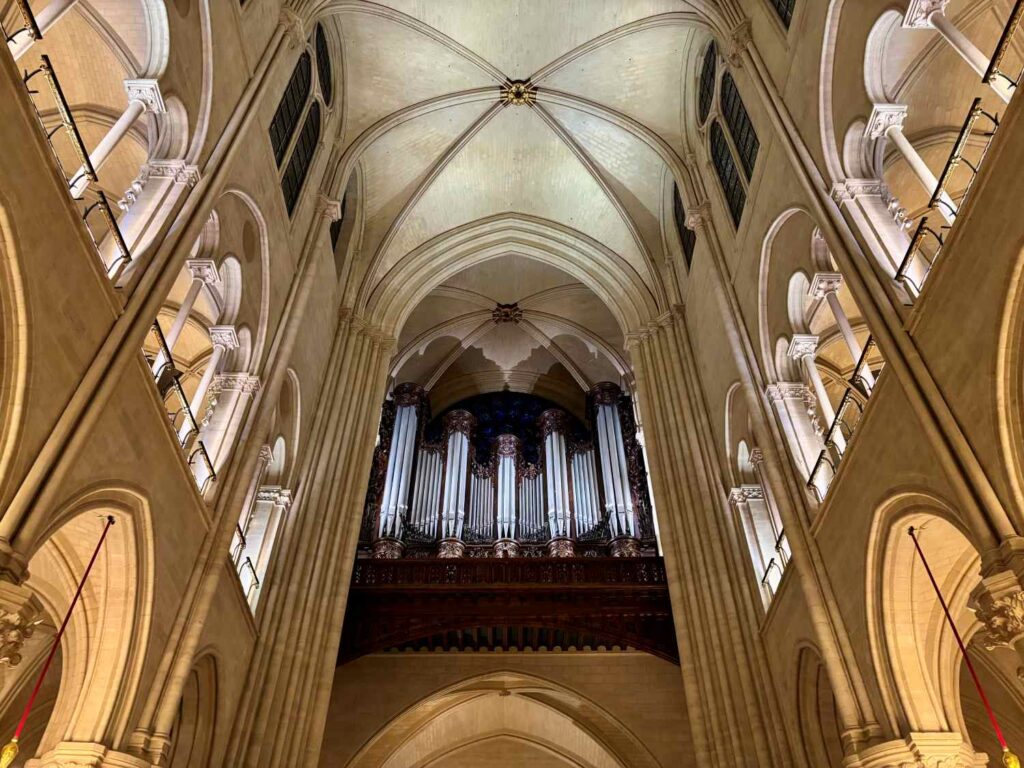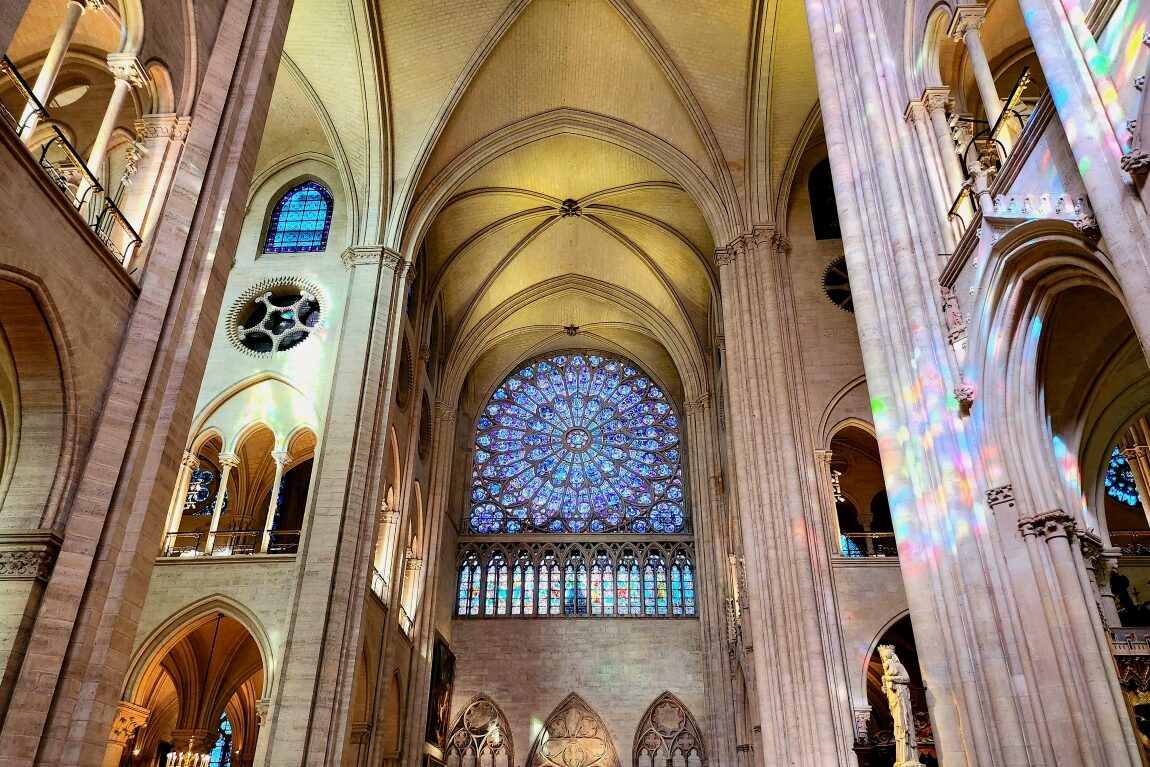Table of Contents
After five years of meticulous restoration, the legendary Notre Dame Cathedral reopened its doors in December 2024. The return of this architectural icon marked a major milestone, celebrating not just the resurrection of a Gothic treasure, but also the resilience of history and human craftsmanship. Visiting during its first week of reopening was unforgettable—filled with public Masses, special performances, and a tangible sense of reverence and excitement. The renewed interior glows with a sense of rebirth, making the cathedral feel both timeless and brand new.
Here’s a complete guide to the cathedral’s history, the devastating fire, the incredible restoration process, and how to plan your own visit.

Brief History of the Notre Dame Cathedral
Notre Dame Cathedral is not just an architectural marvel; it is a deeply symbolic piece of France’s cultural and religious identity. Construction began in 1163 under Bishop Maurice de Sully. The initial foundation stone was laid in the presence of Pope Alexander III and King Louis VII. The construction spanned nearly two centuries, concluding in 1345. Over this time, Notre Dame became one of the most admired examples of French Gothic architecture, known for its flying buttresses, ornate sculptures, and stunning stained-glass windows.
One of the cathedral’s most sacred possessions is the Crown of Thorns—believed to be worn by Jesus Christ during his crucifixion. King Louis IX brought the relic to Paris in 1239, initially housing it in Sainte-Chapelle before moving it to Notre Dame.
Over the centuries, Notre Dame has played a central role in French history—from the coronation of Henry VI of England in 1431 to Napoleon Bonaparte’s self-coronation in 1804. During the French Revolution, however, it suffered heavy damage: religious icons were removed, statues destroyed, and it was briefly transformed into a Temple of Reason. Thanks to Victor Hugo’s novel The Hunchback of Notre-Dame published in 1831, public interest was reignited, leading to a major restoration in 1844, led by Eugène Viollet-le-Duc. That same restoration introduced the iconic spire lost in the 2019 fire.
The 2019 Fire: What Happened to Notre Dame?
On April 15, 2019, tragedy struck. A fire broke out beneath the cathedral’s roof and quickly engulfed the ancient wooden frame—nicknamed “the forest” because it was built from over 1,000 oak trees. Flames consumed the roof and caused the collapse of the 19th-century spire. The damage was extensive, affecting both the structure and the intricate stonework.
However, the efforts of firefighters and emergency personnel prevented even greater loss. The bell towers, façade, and several invaluable relics, including the Crown of Thorns, were saved. The cathedral’s famous organ and many interior artworks survived, though they needed deep restoration. The cause of the fire remains unclear, though investigators believe it may have been linked to ongoing renovation work or faulty wiring.
The world responded with overwhelming support—nearly €1 billion was pledged to restore Notre Dame to its former grandeur.

What Has Changed at Notre Dame Cathedral?
Restoring Notre Dame was one of the most ambitious heritage projects in recent history. Let’s explore some of the most significant updates.
The Rebuilt Spire
Destroyed in the 2019 fire, the iconic 93-meter spire has been reconstructed with incredible care. Oak from French forests was used to replicate the original timber structure, and lead sheeting restored the external aesthetic. The spire was hoisted into place using Europe’s largest crane, a monumental effort that brought back one of the cathedral’s most recognizable features.
Major Cleaning
One of the first things you’ll notice upon entering is how bright the interior now looks. Each limestone block was scrubbed and restored, some replaced with stones sourced from the same ancient quarries used in the 12th century.
The stained-glass windows, including the famous rose windows, were spared from the flames but suffered damage from smoke and heat. They were removed, cleaned, and meticulously restored to their original vibrancy by expert artisans.
Rebuilding “The Forest”
The medieval wooden framework of the roof—known as “The Forest”—was completely destroyed. Thanks to detailed historical documentation and modern 3D modeling, it was reconstructed using more than 1,000 specially selected oak trees. Craftsmen used traditional carpentry methods to ensure authenticity.
Preserving the Grand Organ
Notre Dame’s grand organ, comprising over 8,000 pipes, survived the fire but was coated in soot. Each pipe was disassembled, cleaned, and restored before being carefully reassembled. The organ was then recalibrated to restore its powerful, resonant sound.

Ongoing Restoration Projects
Even though the cathedral reopened in December 2024, work is still underway. Scaffolding remains at the eastern end, especially near the apse and sacristy. Restoration here is expected to continue into 2025 and beyond.
Meanwhile, a major project to transform the esplanade in front of the cathedral is scheduled to begin in 2025. It aims to make the area greener and more accessible, with completion expected by 2030. There are also proposals to establish a museum inside the nearby Hôtel-Dieu hospital, dedicated to Notre Dame’s history and cultural significance.
Visiting the Reopened Notre Dame Cathedral
As of December 10, 2024, Notre Dame Cathedral is open once again to the public for both spiritual visits and tourism. Whether you’re coming for prayer or simply to marvel at its architecture, the experience is unforgettable—and best of all, it’s free.

Booking Your Visit
Though entry is free, visitors are encouraged to reserve time slots to avoid long queues, especially during weekends and holidays. Time slots often get snapped up quickly, so booking one or two days in advance is a smart move. Even if you don’t have a reservation, you can still enter the cathedral—just be prepared for longer wait times.
Currently, you can check availability and updates on the official Notre Dame Cathedral website or via the cathedral’s mobile app. The process is simple: select a time slot, confirm your visit, and receive a digital ticket via email. The goal is to help manage the flow of visitors while preserving the serenity of the space.
Opening Hours
Here’s when you can visit Notre Dame:
- Monday to Friday: 7:45 AM – 7:00 PM
(Extended to 10:00 PM on Thursdays) - Saturday and Sunday: 8:15 AM – 7:30 PM
Note: Last entry is 30 minutes before closing.
Concerts and Performances
Beyond sightseeing, the cathedral is also resuming its long-standing tradition of music. Regular concerts are planned, showcasing sacred choral and organ performances. These concerts are held inside the cathedral and offer a one-of-a-kind acoustic experience. You can find the event calendar and ticket information on the official Sacred Music at Notre-Dame de Paris website.
Getting to Notre Dame Cathedral
Located on Île de la Cité, right in the middle of the Seine River, Notre Dame Cathedral is situated in the historic core of Paris. It’s surrounded by picturesque views, cobbled streets, and is just a stone’s throw from several other must-see landmarks.
By Metro
- Cité (Line 4) and Saint-Michel (Line 4) are the nearest metro stops.
- You can also reach it via Hôtel de Ville (Lines 1 & 11) or Châtelet (Lines 7, 11, 14), both within walking distance.
By RER Train
- The closest RER station is Saint-Michel–Notre-Dame (RER Lines B and C). From there, it’s just a 5-minute walk to the cathedral.
The area is very walkable, and you’ll enjoy beautiful views along the riverbanks no matter which route you choose.
Using the Guides and Mobile App
Notre Dame is filled with rich detail, and to truly appreciate it, having a guide is invaluable. Upon arrival, visitors can purchase a printed Visitor Guide for €10, which outlines the major historical and artistic highlights of the cathedral. A separate Pilgrim Guide for €5 offers a more spiritual, prayer-focused journey through the site.
The official mobile app offers a more interactive way to explore. It includes several self-guided audio tours in English, French, and Spanish. These tours can be downloaded ahead of time or accessed on-site using Wi-Fi.
Tour Options Include:
- “Visit the Cathedral” – A comprehensive 35-minute walk-through of the main architectural features.
- “Visit as a Pilgrim” – A spiritual 45-minute journey.
- “Visit with Family” – Tailored to young visitors, lasting about 25 minutes.
There’s also a charming gift shop where visitors can browse a range of items, from books and postcards to religious items and art inspired by the cathedral.
Why You Should Visit Notre Dame Now
Whether you’ve seen Notre Dame in its former glory or this will be your first time, the newly restored cathedral offers a powerful experience. From the moment you step inside, the restored stonework, polished stained-glass windows, and glowing ambiance transport you through time. It’s more than a tourist attraction—it’s a living monument to human resilience, craftsmanship, and faith.
There’s also an emotional aspect to seeing Notre Dame now. The scars of the 2019 fire have been replaced with symbols of revival. Everything from the wooden vaults to the delicate organ pipes reflects a spirit of restoration that breathes fresh life into a centuries-old structure.
For returning visitors, the contrast between the pre- and post-fire cathedral is striking. And for newcomers, there’s the joy of discovering this icon at its most luminous. Whether you’re there to pray, admire the art, or simply soak in the atmosphere, Notre Dame offers a renewed perspective on history, architecture, and spirituality.
So if Paris is on your radar anytime soon, make Notre Dame a top priority. No matter your beliefs or background, it’s an experience that leaves a lasting impression.
FAQs
1. Is it free to enter the Notre Dame Cathedral now?
Yes, entrance is completely free. Reservations are optional but highly recommended to skip the line during peak hours.
2. Can I still see the Crown of Thorns and other relics?
Yes, many of Notre Dame’s sacred relics, including the Crown of Thorns, are still housed within the cathedral and viewable during certain religious events or special displays.
3. Is there an audio guide available?
Absolutely. The official Notre Dame mobile app offers downloadable guided tours in multiple languages, including English, French, and Spanish.
4. Are there still parts of the cathedral under construction?
Yes, although the cathedral has reopened, some restoration work continues, especially on the eastern end and the surrounding esplanade.
5. Can I attend a Mass or concert inside the cathedral?
Yes. Masses are held regularly, and concerts featuring sacred music are scheduled throughout the year. Check the official event schedule for times and ticket availability.




